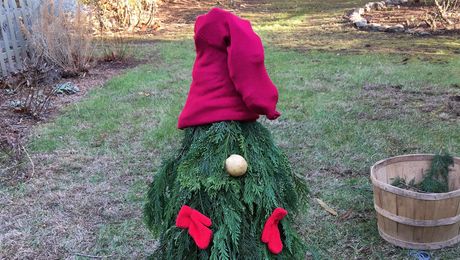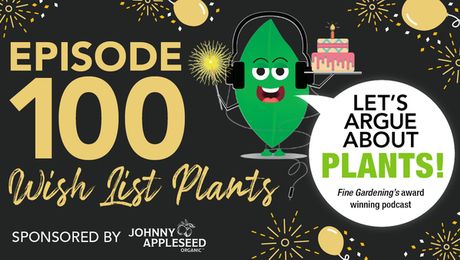What Are The Best Plants For Container Gardens
Design
10 Plants for Year-round Containers
These survivors can stay in pots for years, lending consistency to your designs

When the air turns chilly in fall, gardeners often discard, propagate, or find a home in the ground for their outdoor potted plants. It's a pity because much of this is a waste of effort and plants. Many perennials and shrubs can live for several years in a container. By taking advantage of this characteristic, you can reduce the amount of time and money you spend on your pots. Your containers can provide you with year-round interest, depending on the plants you choose, and you can lend consistency to your designs.
For a plant, life in a container is much different than one in the ground. Containers can provide excellent drainage, but the plants depend on you for water and nutrients. Shrubs and larger perennials often stay smaller in a pot, though this depends on the plant, climate, and container. Also, containers don't insulate a plant's roots from winter temperatures.
The general rule of thumb for container-plant survival through the winter is that the plant should be hardy to two zones colder than your USDA Hardiness Zone. But in my Maryland garden, which barely qualifies as Zone 7, I have successfully overwintered plants that shouldn't have made it and I have failed with some that should have. Through trial and error, I have found a wide array of plants that can live year after year in a container. I have selected the 10 best that are not only tough enough to survive but also look great while doing it.
1. 'Golden Sword' yucca combines with almost anything

One pot, four seasons – Yucca and bergenia are the core plants in this container, shining in summer and fall. In winter, when the bergenia has died back, stems from yellow and redtwig dogwoods add to the yucca's colorful display. In spring, before the yucca and bergenia have returned to form, pansies and lamium steal the show.
I highly recommend 'Golden Sword' yucca (Yucca filamentosa 'Golden Sword', Zones 4–11) because it combines easily with so many plants. Its 2-inch-wide, swordlike leaves have margins that are thin and dark green, centers of golden yellow, and curly fibers along the edges. Having a spiky, architectural shape, it grows 2 to 3 feet high with equal spread.
This yucca tolerates some shade but thrives in sunny, dry conditions. In summer, creamy white, fragrant flowers emerge from the center of the plant on 3- to 6-foot-tall stems. In late winter, the foliage may get a little flat, but it will perk up again in spring. Pull off the old foliage to maintain a tidy appearance.
2. 'Green Mountain' boxwood keeps its color all year

It's tough, but living in a container will keep it smaller than its normal 5-foot height and 3-foot width. Place 'Green Mountain' away from strong winds in a semi-shaded location. If possible, periodically rotate the pot to balance the plant's exposure to light and to avoid the development of bare sides. 'Green Mountain' boxwood (Buxus 'Green Mountain', Zones 4–9) is a slow-growing shrub that, unlike many other boxwoods, retains a dark green color throughout the winter. I particularly like this cultivar because it grows into a graceful pyramid rather than turning into a meatball-shaped shrub.
3. Golden creeping Jenny is perfect for the edge of the pot
Golden creeping Jenny (Lysimachia nummularia 'Aurea', Zones 4–8) is truly a reliable performer in a container. This 4-inch-tall plant cascades beautifully over the rim of a pot. Its golden, coin-shaped leaves look good with everything. It likes partial shade but loves water, so much so that it will grow in a water garden. It can take full sun, too, but you need to keep the soil moist.

4. Japanese pieris has colorful new growth
This deer-resistant shrub (Pieris japonica and cvs., Zones 6–8) is an excellent candidate for containers. Though its evergreen foliage provides interest in all seasons, the spring growth on Japanese pieris is especially striking, varying in color from glossy red to salmon pink to creamy white, depending on the cultivar.
In winter, the flower buds are showy—usually dark red, with some opening to shades of pink. Delicate 3- to 6-inch-long racemes of white, urn-shaped blossoms appear in early spring, and they bear a slight fragrance. The graceful branches of this shrub drape naturally over the edges of pots.
Compact forms such as 'Dorothy Wyckoff' grow densely so that smaller plants are not always necessary for an attractive container display. Japanese pieris grows in full sun to full shade. Protect it from winter's harsh winds and strong sun.
5. 'Emerald' arborvitae works where you need some height
The shape and texture of its foliage make it easy to combine with other plants. A container will keep it well under its natural size of 15 feet high and 4 feet wide. Plant it in full sun or light shade.Emerald arborvitae (Thuja occidentalis 'Emerald', syn. 'Smaragd', Zones 2–7) provides excellent year-round interest because it maintains its rich green color in winter. The upright, narrow habit of this cultivar of our native arborvitae fits the bill as the vertical accent that many containers need.

6. Bergenia has bold leaves that shine in containers
With its green, glossy, oval leaves, bergenia (Bergenia cordifolia and cvs., Zones 3–8) is one of my favorite plants because it is a strong grower that provides a bold element in a container design. The leaves are anywhere from 10 to 20 inches long and 6 to 8 inches wide, and turn a gorgeous burgundy in fall. Bergenia flowers in early spring on 12- to 15-inch-long stalks; the pink blossoms resemble hyacinths.
The plant actually performs better in my containers than in my beds, perhaps because of the excellent drainage. Grow it in full sun or light shade.
Tips for overwintering plants in containers
Select a frostproof container. Choose a pot with a drainage hole in the bottom and made of fiberglass, lead, iron, heavy plastic, or stone. Most terra cotta will crack in cold temperatures, but I have had luck with glazed pottery.
Use a good potting soil. There are mixes specifically made for use in containers, which provide the essential drainage that plants living in pots need.
Stop feeding in fall. If you use a water-soluble fertilizer, stop feeding your plants about six to eight weeks before your first frost date. This will prevent any tender new growth, which wouldn't survive the winter. Begin fertilizing again when the plants resume growth in the spring.
Water into winter. Water as needed until the soil in the container is frozen. Do not water frozen pots because the plants are unable to absorb the water.
Apply an antidesiccant. Use products such as Wilt-Pruf on broadleaf evergreens and conifers to protect against damage from winter winds.
Repot every few years. Though some plants will live longer in a container, repot your plants every three years to be on the safe side.
7. Variegated red-twig dogwood is big and beautiful
The shrub's variegated leaves are a handsome foil to the hydrangeas in the ground on either side of it, and a mass of variegated Solomon's seal near the base of the container conceals it most of the year. The dogwood's deepest color appears on young stems, so remove old branches in early spring. Place this shrub in full sun to half shade, and watch out for an attack by Japanese beetles in summer.Another shrub that performs nicely in a container is variegated red-twig dogwood (Cornus alba 'Elegantissima', Zones 2–8). Its leaves have white margins and grayish green centers, and the bright red stems shine in winter, particularly if given an evergreen backdrop. A single 'Elegantissima' growing in a 24-inch-wide, blue ceramic pot has worked for three years as a focal point in one of our borders.

8. Heucheras provide small spots of interest
Heucheras (Heuchera spp. and cvs., Zones 3–8) are attractive, low-growing perennials that excel at providing interest below the taller plants in a container. Their lobed foliage can be showy, often possessing silver veins through green or purple leaves. Heucheras are particularly suited for containers because they like well-drained soil and recover easily from winter. Most heucheras grow into a 12- to 18-inch-diameter mound and toss up flower panicles with white, pink, or red blossoms. They can grow in full sun to full shade, depending on the cultivar.
9. 'Blue Star' juniper has a useful color
The low-growing 'Blue Star' juniper (Juniperus squamata 'Blue Star', Zones 4–9) has tightly arranged, 1/4-inch-long, steel blue needles. This color makes the plant stand out in winter. It reaches 3 feet tall with a 3- to 4-foot spread, but it is slow growing. It works well in containers because it combines easily with most colors and the branches arch elegantly over the rim of a pot. It prefers full sun but will take partial shade. It doesn't like humid conditions.

10. 'Fuldaglut' sedum is a small plant that makes a big splash
The dominant feature of 'Fuldaglut' sedum (Sedum spurium 'Fuldaglut', Zones 4–9) is the bronze red leaf color that becomes red in winter. The delicately scalloped foliage has larger leaves than most of the species, and in late summer, it is topped with cerise blooms that last as long as three weeks. At only 6 inches tall and 12 inches wide, this sedum dresses up a container's edge and even makes a good cut flower for small bouquets. It likes full sun but will grow in partial shade.
Get our latest tips, how-to articles, and instructional videos sent to your inbox.
Related Articles
The Latest
Design
Gardening With the Spirit of the Season
Long-time Garden Photo of the Day contributor Cherry Ong may be the poster gardener for the spirit of the season. It has become a tradition for Cherry to make wreaths…

Design
Build a Holiday Garden Gnome
After such a long and dreary year, we could all use a celebration. Add some cheer to your front yard this holiday season with an adorable holiday garden gnome built…

Podcast: Let's Argue About Plants
Episode 100: Wish List Plants
Well loyal listeners, it's hard to believe, but this is our 100th episode! We cannot thank everyone out there who has stuck with us from the early days of trying…

Holiday Subscription Savings - Limited Time!
$10 for a year
of Fine Gardening Magazine
Subscribe Today
-

How-To
Giving Back Through Gardening: Part 2
Back in May, Fine Gardening committed to planning and planting a garden for Karen, an emergency department nurse. It was a small way to say thank you for the efforts…
What Are The Best Plants For Container Gardens
Source: https://www.finegardening.com/article/10-plants-for-year-round-containers
Posted by: nishimuranaturawrove.blogspot.com


0 Response to "What Are The Best Plants For Container Gardens"
Post a Comment